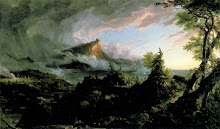Summary:
Through seven characters , Plato discusses differing philosophical views on love. These philosophers discuss how love can better society by promoting self-sacrifice as well as cause harm if rooted in bodily desire. Aristophanes, for one, thinks of love as both a form of punishment for human transgressions as well as a way to reconnect with our "missing" selves. Socrates, however, describes love as a balancing force, a "mean" between the mortal world and the eternal.
Assumptions:
Through discourse, one comes closer to reaching the truth.
Multiple voices add to understanding.
Men valued more than women.
Love between men is normal.
Artists are creators of a higher quality than human creators.
Reinforcing or New Ideas:
Greek scholarship valued. Many voices past and present contribute to current scholarship.
Thus, Homer, Herodotus, Socrates all cited.
Humor at the end with the entrance of the drunk could suggest that this subject or any philosophical discussion shouldn't be taken too seriously, or it could act to connect the aforementioned ideas.
Humor and the base instincts coincide with lofty ideals.
Questions:
What is the purpose of the drunk?
Why does Plato speak through others? Where is Plato in all this?
Links:
John Updike died recently. An obituary quoted something he told Life Magazine in 1966: "I like middles. It's in the middle that extremes clash, where ambiguity restlessly waits." This reminds me of what Socrates says about love existing between extremes, between the fair and the foul, as the "intermediate between the divine and the mortal" (160). In mythology, at the beginning of the Greek creation myth, Eros brought together earth and sky out of Chaos. This, too, suggests that Eros exists between the extremes. This concept of balance is present in Shakespeare (where most characters lack the necessary balance) as well as Jane Austen novels, where the heroine has to learn to balance opposing forces within herself.
I also was reminded of the art the Roman leader Hadrian had created in memory of his lover, Antinous after his death (suicide).
Subscribe to:
Post Comments (Atom)
.jpg)
.jpg)
.jpg)
No comments:
Post a Comment